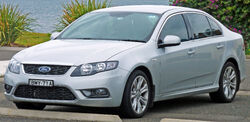 | |
| Manufacturer | Ford Motor Company of Australia |
|---|---|
| Also called |
Ford Fairmont Ford Futura Ford G6 |
| Production | 1960–present |
| Assembly | Campbellfield, Victoria, Australia |
| Predecessor | Ford Zephyr, Ford Zodiac |
| Class | Full-size |
| Body style(s) |
4-door sedan 5-door station wagon 2-door utility 2-door panel van 2-door hardtop |
| Layout | Front-engine, rear-wheel drive |
The Ford Falcon is a full-size car which has been manufactured by Ford Australia since 1960. Each model from the XA series of 1972 onward has been designed, developed and built in Australia and/or New Zealand, following the phasing out of the American Falcon of 1960-71 which had been re-engineered locally for the harsher Australian conditions. As a result of the longevity of its Australian production, the Falcon is one of the biggest selling names in world automotive history, selling over 3,000,000 in six generations to 2003, almost exclusively in Australia and New Zealand.[1] As of July 2007, Ford sells upwards of 3,000 units per month.[2]
Ford has manufactured over three million units since 1960, and has topped the sales charts in Australia on many occasions. Currently the Falcon line-up is offered in sedan and utility body styles, however in the past panel vans, station wagons, and hardtops (coupes) were offered.[3] Australian made Ford Falcons and Holden Commodores dominate the ranks of taxis in Australia and New Zealand, and are also used as police patrol cars.
Luxury variants of the current model Falcon, collectively known as the G Series, are marketed as the Ford G6, G6E and G6E Turbo. Other Falcon based models developed by Ford Australia, but no longer in production, are the Ford Futura, Ford Fairmont and Ford Landau, as well as the long wheelbase Ford Fairlane and Ford LTD.
First generation (1960–1966)[]
During the 1950s, Ford's Australian sales were faltering due to the popularity of the Holden which did not have an effective competitor. Ford assembled the English Zephyr and its Consul and Zodiac derivatives. However, while these cars were moderately successful and had a good reputation, Ford could not match Holden's price, and so sales suffered. One of the reasons for the price difference was the higher cost of imported parts, which were subject to an import tariff. Ford also assembled Canadian-sourced Ford V8 models, but these cars were in a higher price category, putting them out of reach of the average buyer.[4]
Hence, Ford decided to commence local production of a Holden challenger. Initially they intended to produce the Zephyr, using expensive dies they would need to purchase from Ford England. However, during a visit to Ford headquarters in Detroit in 1958, they were shown the new Falcon, which was being prepared for its US launch. Immediately, the executives were attracted to the new car- it was about the same size as Holden, but it was low, long, wide and modern. The width allowed it to accommodate 6 people, and a 2-speed automatic transmission was available. Besides all this, Ford Australia felt they had more experience building North American cars. Hence they decided to make Falcon their new Australian car. In 1959, Ford built a factory at Broadmeadows, a suburb of Melbourne, for local production of the North American Ford Falcon. The factory was designed in Canada, and had a roof which would facilitate dispersal of snow - notwithstanding the fact that snow does not usually fall in Melbourne.
XK[]
- Main article: Ford XK Falcon

1960 Ford XK Falcon sedan
The first Falcon sold in Australia was the XK series, introduced in September 1960. It was initially offered only as a four door sedan, in both Falcon and Falcon Deluxe trim levels. The XK was essentially a right hand drive version of the North American model, although local country dealers often included modifications such as heavy duty rear suspension (5 leaves) and larger 6.50 x 13 tyres.
The steering was light and the ride surprisingly good, on well-paved roads. The Falcon's 'king-size' drum brakes actually had less lining area than the Zephyr's, but they were stopping a car that was over 100 kg lighter, so were adequate. Whereas the North American model used an 'economy' 3.10 to 1 rear axle ratio, the Australian Falcon was built with a 3.56 to 1 ratio which better complemented the torque characteristics of the engine, and yet still allowed a reduction in cruising rpm when compared with the Zephyr.
The station wagon, added to the range in November 1960, lacked the American version's extended rear overhang due to concern that the back of the car might scrape on rough roads and spoon drains.
Billed as being "Australian-with a world of difference", Falcon offered the first serious alternative to Holden, and became an instant success. Sales were aided by the contemporary FB series Holden being perceived as lacklustre and dated by comparison. A 170 cu in engine was introduced late in the model's life.
However, before long, XK sales suffered from complaints about the durability on rough outback roads (due chiefly to collapsing front ball joints, and adjusting shims dropping out of the front suspension, both problems inducing some rather severe front camber); the car earned the unflattering nickname "Foul Can" during this time.
The XK range was expanded in May 1961 with the addition of utility and panel van body styles, officially designated as Falcon Utility and Falcon Sedan Delivery respectively.[5]
XL[]
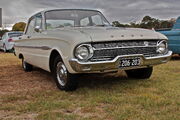
1962 Ford XL Falcon sedan
- Main article: Ford XL Falcon
Ford Australia introduced some local design changes to the XL in early 1962, such as a heavier suspension system with components from the Fairlane. Also, the appearance was changed with a new Thunderbird roofline. The slogan was 'Trim, Taut, Terrific'. Nevertheless, the Falcon was still widely perceived as unsuitable for local conditions and sales stagnated. Ford stuck with the Falcon and sales gradually increased over the following years as improvements to durability and reliability were applied.[6]
New for the XL series were the top of the range Falcon Futura Sedan and the Falcon Squire Station Wagon, the latter featuring simulated woodgrain exterior side and tailgate paneling.[5]
XM[]

1964 Ford XM Falcon Police Van
- Main article: Ford XM Falcon
The XM, released in 1964, was the first Falcon with an Australian-designed body; the rear taillights were raised for Australian conditions and the front end received a full-wrap chrome grill and surrounds. The steering linkage was upgraded with 9/16-inch tie rods instead of the 1/2-inch tie rods found in the US models. The suspension was also improved with the upper control arms lowered to reduce the notorious bump steer found in the North American Falcon (and early Mustangs), that this model was based on.
A new two-door hardtop body style was offered for the first time, in both Falcon Deluxe and Falcon Futura trim levels.[5]
XP[]
- Main article: Ford XP Falcon

1965 Ford XP Falcon Utility (2006 unrestored) incorrect mirrors
The following model, the XP, saw the Fairmont introduced as an upmarket variant. The XP was the "make or break" Falcon: Ford's future in Australia depended on this car succeeding. Ford's Deputy Managing Director Bill Bourke conceived a promotion for the new model which was a major gamble: demonstrate the XPs strength by mercilessly driving a fleet of XP Falcons around its You-Yangs testing grounds for 70,000 miles (110,000 km) at over 70 mph (110 km/h). The gamble paid off with the Falcon winning the prestigious Wheels Car of the Year award. A 3-speed automatic progressively replaced the 2-speed and front disc brakes were introduced as an option (standard on Fairmont and Hardtop models).[7]
This model was also the last to see the Squire range of Ford Falcons which featured wood panels on the side of the wagons, similar to the USA based station wagons. The Fairmont made its debut, mid-way through the model run, as the flagship of the XP Falcon range. It was offered in both sedan and station wagon body styles, replacing the Futura sedan and Squire wagon. Unlike later examples, the XP Fairmonts carried both Falcon & Fairmont badgework.[5]
Additionally in the XP range several cars were modified by Bill Warner to install a 260ci/289ci V8 and a three speed automatic or four speed manuals. These cars are discussed as a precursor to the GT Falcon which debuted in the next model or as XP Falcon Sprint's.[8]
Second generation (1966–1972)[]
XR[]
- Main article: Ford XR Falcon
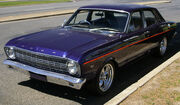
1966 Ford XR Falcon
The next new model Falcon, the XR series, was introduced in September 1966. Styling was based on the third generation 1966 US Ford Falcon and it was promoted as the "Mustang bred Falcon". It was the first Australian Falcon to be offered with a V8 engine, the 200 bhp (150 kW), 289 cubic inch (4.7 litres) Windsor unit.[9] The XR marked the first time a V8 engine could be optioned in all trim levels of an Australian car, V8s having previously been reserved for the more up-market variants. The 144 cubic inch (2.4 litre) six cylinder engine was deleted for the XR series leaving the 170 cubic inch (2.8 litre) six as the base Falcon engine.[5] A 200 cubic inch (3.3 litre) six was also available.[9]
The XR series was initially offered in nine different models: Falcon, Falcon 500 and Fairmont Sedans, Falcon, Falcon 500 and Fairmont Wagons, Falcon and Falcon 500 Utilities and the Falcon Van.[9] The new wagons shared the 111-inch (2,800 mm) wheelbase with the XR sedans, unlike the 1966 US Falcon wagons which featured a 115-inch (2,900 mm) wheelbase.[10] The Falcon 500 replaced the Falcon Deluxe of the XP series[10] and the two door hardtop body style available in the XP series was not offered in the XR range.[5]
The Falcon XR won the Wheels Car of the Year award in 1966, giving Ford Falcon two straight wins.

Ford XR Falcon GT in Gallaher Silver
The marketing focus on the Falcon's relationship with the Mustang's sporty appeal led to Ford introducing a Falcon GT variant of the XR in 1967, featuring a 225 bhp (168 kW) version of the 289 cubic inch (4.7 litre) Windsor V8 engine, sourced from the Ford Mustang. The GT heralded the dawn of the Aussie muscle car. All of the original XR GTs were painted in the colour 'GT Gold', except for eight that were "Gallaher Silver" and another five that were "Russet Bronze, Sultan Maroon, Polar White, Avis White and Ivy Green". The non-gold GTs, while having the same specifications, are the rarest of the early Australian muscle cars.
Also specified on the first GT Falcon was a Hurst shifter for the 4spd gearbox, deep dish sports steering wheel, sports instrumentation, chrome full-cover wheel trims, and thick 'GT stripes' along the lower panels between front and rear wheels.
XT[]
- Main article: Ford XT Falcon

Ford XT Falcon GT
The 1968 XT model featured a mild facelift, with a divided grille, and inset driving lights for the GT. The GT also replaced the thick lower body stripes of the XR with narrow stripes along the waistline from grille to tail light. The tail lights were still round but instead of the small round indicator of the XR, the XT model had a long indicator across the light. Otherwise all external bodypanels and bumpers were the same as the XR. Inside, the XT gained a 'strip' speedometer in place of the round gauges of the XR.
The XT buyer also could choose a 188 cu in (3.1 L) or a 221 cu in (3.6 L) 6-cylinder engine.
The 289 cu in (4.7 L) V8 engine was replaced by a new 302 cu in (4.9 L) unit.[5]
The XT is not to be confused with the similarly named base-model Falcon XT of 2002-current.
XW[]
- Main article: Ford XW Falcon
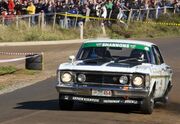
1969 Ford XW Falcon GT (replica) racing in Targa Tasmania
The 1969 XW Falcon introduced bolder styling which featured raised ridges down each front guard and a 'buttressed' c-pillar (although the rear windscreen was not relocated), which made the cars appear larger than the XR/XT models. A new dashboard and trim variations also appeared. Factory-fitted fully integrated air conditioning was made available as an option for the first time.
The GT variant gained a bigger V8, the 351 cu in (5.8 L) Canadian-made Windsor engine, producing 291 horsepower (217 kW). The styling of the GT went wilder with the addition of an offset racing-style bonnet scoop, bonnet locks and blackouts, as well as 'Super Roo' stripes along the full length of the car (these and the bonnet blackouts were a 'delete option'). GT wheels were now 10-slot steel with flat centrecaps over the lug nuts and stainless steel dress rims. The twin 'driving lights' introduced on the XT GT were carried over to the XW GT.
If that was not enough indication of Ford's 'Win on Sunday, sell on Monday' racing ambitions, the XW also saw the introduction, in August 1969, of the legendary GT-HO specification. The GT-HO was a homologation special built for racing. Externally it was almost indistinguishable from a standard GT, but offered a higher performance engine and improved suspension— although the 'HO' stood for 'Handling Option' the cars also gained larger Holley carburettors and other performance additions. The Phase I or 'Windsor HO' was fitted with the 351ci Windsor V8 but was replaced a year later with the 351 Cleveland, producing 300 horsepower (220 kW) in the Phase II GT-HO. Phase II GT-HO wheels featured a new 5-slot design.
The XW also gained a GS ('Grand Sport') option, which could be optioned with the 188 cu in (3.1 L) and 221 cu in (3.6 L) six cylinder, 302 cu in (4.9 L) Windsor V8 but not the 351 cu in (5.8 L) Windsor V8 on Falcon 500, Futura and Fairmont. It offered the same dash as the GT with sports instruments, sport wheel trims and stripes. The GS lasted until the 1978 XC series I model; longer than the GT, which finished with the XB.
XY[]
- Main article: Ford XY Falcon

Ford XY Falcon 500
The venerated XY was released in October 1970, with variations to grille and tail lights but otherwise unchanged bodywork from the XW. The six cylinder motors were bigger—200 cu in (3.3 L) and 250 cu in (4.1 L). A 2V (i.e., 2-barrel carbureted) version of the 351 Cleveland V8 was an option on all sedans. All GT models remain valuable collectors' cars and this is especially true of the XY GT and XY GT-HO Phase III, released in 1970.
The GTs styling went wilder again with a 'Shaker' cold-air induction scoop protruding from a hole in the bonnet, which now sported twin wide GT stripes from grille to windscreen, rather than the bonnet blackouts of the XW. The thick side stripes remained, although altered slightly, as did the twin driving lights and blacked out panel between the tail lights. Wheels were now the 5-slot steel items first seen on the XW Phase II GT-HO. The Phase III GT-HO also sported a plastic front spoiler and a wild bootlid spoiler styled after those fitted to the Mach series Mustangs.
The upgraded Cleveland V8 in the 1971 XY GT-HO Phase III produced an estimated 385 brake horsepower (287 kW), although Fords official figures for this motor were much lower. The 750cfm Holley carburettor of the XW GT-HO Phase II was replaced by a 780cfm Holley, along with numerous other performance modifications. The Phase III was Australia's fastest four-door production car and possibly the fastest four-door sedan in the world at the time, with a top speed of 141.5 mph (227.7 km/h).[11] Power figures are still debated today as Ford still claimed 300 hp (220 kW) as the standard 351 Cleveland V8 in the GT though the GT-HO Phase III received many modifications to increase its reliability and race performance. In 1972 Ford made the 15-inch Globe 'Bathurst' alloy wheels available as an upgrade to the GT-HO Phase III.
During the life of the XY model, the uniquely Australian uprated 200, 250 1V and 250 2V variants of the seven-main-bearing 6 cyl. were introduced. Cleveland V8s were imported initially, until the Geelong Foundry began to produce these motors for automatic Falcons in mid 1972. The transmissions included both Ford & Borg-Warner, as did rear axles. The XY is now widely regarded as the best Falcon made in Australia, not just with its Bathurst dominance but also in its performance, build quality and refinement, which was superior to competitors at the time. Current values for XYs compared to other Aussie Falcons, and their competitors, attest to this.
Australia's first production 4-wheel drive car-based vehicle—a utility—was introduced by Ford as an XY model in 1972. All were fitted with the 250 cubic inch 6 that was mounted on a 30 degree slant to provide front axle suspension clearance between the front diff and the sump.
Third generation (1972–1979)[]
XA[]
- Main article: Ford XA Falcon
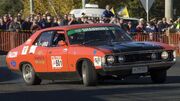
1972-1973 Ford XA Falcon GT (replica) racing in Targa Tasmania
The end of production of the Falcon in the US paved the way for much greater Australian input in the design of Australian-made Falcons, from 1972 onwards, although for several years there was still a distinct resemblance to the US-made Mustang. The XA Falcon, introducing a new hardtop coupe model, burst onto the scene with its distinctive range of paint colours, with purple and wild plum being popular, often ordered with white or black upholstery. The XA Falcon Hardtop bore a strong resemblance to the 1970-71 Ford Torino, and shared its "frameless window" doors with the utility and panel van variants. The drivetrains carried over from the XY, although the 250-2V was soon dropped, and the 'full-house' GT-HO engines no longer required due to changes in production racing regulations. Ford had planned a 'Phase IV' GT-HO (and built four), but cancelled it in the wake of the so-called 'Supercar Superscare'.
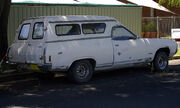
Ford XA Falcon panel van
The GT variant kept the twin driving lights but reverted to a bonnet blackout with no strips at all on the vehicle. The front guards received fake 'vents' just behind the indicators, and NACA ducts were added to the bonnet. Steel '12-slot- wheels were re-introduced although some GTs received the 5-spoke Globe 'Bathurst' wheels, which had been ordered for the GT-HO Phase IV and now needed to be utilised. The GT's rear suspension featured radius rods to help locate the elliptical spring solid rear axle. Other performance parts from the aborted Phase IV found their way onto GTs, including larger fuel tanks and winged sumps. These specced up GTs are generally referred to as 'RPO83's after the option code covering the additional parts, although what parts any given RPO83 received seems to have been governed by the luck of the draw rather than any specific process.
From the rear, XA hardtops can be distinguished from later models by the tail lights, which have lenses which slope inwards (towards the front of the vehicle).
XB[]
- Main article: Ford XB Falcon

1973–1976 Ford XB Fairmont GS V8
In 1973 the XB Falcon (sold with the slogan "The Great Australian Road Car") was introduced with more aggressive styling, a multi-function control stalk (indicators, high beam, horn), new colours including colour-coded bumpers on the GT variants, and minor trim variations. Engine options were as before, but the 170 bhp (130 kW) six was dropped. New Panel Van and Utility trim packages, "Surferoo" and "Surfsider" respectively, were introduced.
Power assisted front disc brakes were now standard across the falcon range. The GT variant of the XB also included four-wheel disc brakes (the earlier GT/GTHO models used large finned drums at the rear). The first 211 XB GTs built were fitted with a US-built version of the Cleveland 5.8 L (351 cu in) V8 known as the 'big port' engine, and later XB GTs were fitted with an Australian-built version of the engine with 'small port' heads. There is a notable difference in performance between these engines, and also in resale value as the early US-powered GTs are rarer and thus more collectable. The twin driving lights remained, as did the bonnet locks. The bonnet scoops were now integrated into the 'power bulge' on the bonnet. The bumpers were now body-coloured, and the power bulge, wheelarches, sills and valances were painted in a contrasting colour to the body (with Yellow Blaze body and black valances seemingly the most popular colour combination).
From behind, XB hardtops can be distinguished from the later XC models by the tail lights, which have flat lenses with chrome bezels.
This classic car is world renowned for its starring roles in the movies Mad Max and Mad Max 2 (The Road Warrior), both starring Mel Gibson. In Mad Max, the police use yellow XA and XB sedans, and Max later drives a customised black XB hardtop known as the Pursuit Special, or incorrectly as the Interceptor.
The Ford Landau, a two door 'personal coupe' based on the XB Falcon Hardtop was released in August 1973.[12]
XC[]
- Main article: Ford XC Falcon
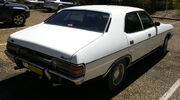
Ford XC Fairmont
In July 1976 Ford introduced the XC Falcon, which was the first model to comply with the new pollution regulations specified under Australian Design Rule 27A. This led to locally produced Cleveland V8s and the introduction of the cross-flow (also called the X-flow) 6cyl. Versions of this engine were produced in America and, in various guises, used in Australian Falcons through to the XF. Its long stroke and large capacity made for very good 'towing' torque, while its thick castings and relatively loose tolerances gave it a reputation for reliability in spite of abuse.
The XC also introduced the country's first locally produced family sedans with a suspension designed around radial ply tyres. Known as "Touring Suspension" (or 'Sports Handling Suspension'), it initially was standard on the Fairmont GXL sedan (optional on other sedans) until it was made standard equipment on all sedans and hardtops in the 1978 'XC½' facelift. For better handling on station wagons, owners could order the stiffer heavy duty suspension package as a no-cost option.
Other changes included a totally different dashboard layout to the XA/XB series, new rear doors with a lower sill cut, air extraction vents in the rear of the c-pillars, and very large bumpers front and rear with no additional valance panel under them.
From behind, XC hardtops can be distinguished from earlier models by the tail lights, which have flat lenses with black bezels.
The Falcon Sundowner Van, based on the Falcon 500 Van, was introduced in 1977. It included options from the Falcon GS Hardtop, such as comprehensive instrumentation, bonnet scoops, slotted sports road wheels and driving lights, but with bodyside protection mouldings and van side glass deleted. Side and rear decals were included in the package, as was the "sedan ride" 500 kg (10cwt) suspension package and ER70H14 radial ply tyres.
In December 1977 Ford built 13 special order XC Falcon GS Hardtops. These Vehicles carried chassis numbers commencing with JG65TE(Verified by Ford). These cars were specially modified in the "parts and accessories" or P&A workshop at Ford's Broadmeadows factory. They were all modified and fitted with the body and mechanical specifications approved in the September 1977 and October 1977 evolution race homologations, these changes were mostly designed to enhance race durability. The vehicles, often referred to as "Pre-Cobras" formed the basis to the special build of 30 Bathurst Cobras (Build Numbers 02-31) that were built six months later in July 1978. It is believed, due to the small production numbers of these Homologated GS Falcon Hardtops and the timing of manufacture, that the batch of 13 cars were built as a one off special order specifically for Ford and privateer race teams which planned to race them in the 1978 Australian Touring Car Championship season. They were also needed to satisfy CAMS, (Confederation of Australian Motor Sport),regulators for minimum production numbers to allow the modifications to be legal for racing. It Is understood that seven were raced and 6 where sold off to dealers that marketed them as "Homologation Packs". The GS Homologation Pack Included the following:
- New Front Spoiler
- New Rear Spoiler
- Reverse Bonnet Scoop
- Spring Tower Brace or K bar
- Spring Tower Reinforcement Bracket
- Steering Idler Arm Support Bracket
- Twin Row Water Pump Pulley with additional drive belt to Crankshaft Pulley
- Transmission Oil Cooler with Braided Lines and pump.
- Long Range Tank with larger filler
- 25mm Larger Rear wheel Housing
- Twin Thermatic Fans each consisting of 10 Blades
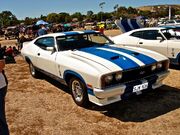
Ford XC Falcon Cobra
In 1978 — inspired by a dominating 1-2 finish for Falcon hardtops at the 1977 Hardie Ferodo 1000 — Ford introduced the limited-edition Cobra which used the last 400 Hardtop bodyshells; each Cobra being individually numbered. Based on the Falcon GS Hardtop, it featured highlights such as Globe 15" alloy road wheels copied from Ferrari intended to aid brake disc cooling, ER70H radial ply tyres, comprehensive instrumentation, bonnet scoops, driving lights, dual exhaust, 4-wheel disc brakes and a distinctive white and blue colour scheme. The 5.8 litre engines were installed in cars numbered 002 through 199 and No 351, and the 4.9 litre engines were installed in the rest (001, plus 200 through 400 except for No 351).
The Falcon, while popular, was usually outsold in Australia by GM Holden's Kingswood until 1978, when it started to gain ground after Holden decided to replace the Kingswood with a smaller model called the Commodore, based on the European Opel models.
Holden gambled that predicted increase of oil prices during this era would drive consumers to choose smaller, more fuel-efficient cars, but the oil price rise never materialised, whilst Ford dealers aggressively pitched the Cortina 6 against the Commodore alternative until the XD Falcon arrived in 1979.
Fourth generation (1979–1999)[]
XD[]
- Main article: Ford XD Falcon

1979–1982 Ford XD Fairmont sedan
Ford's next model Falcon, the XD (Project Blackwood), introduced in 1979, bore many external styling resemblances to the European Ford Granada, but was slightly larger and less luxurious. Improved body reinforcing allowed many reductions in component weight to be made, improving performance and braking. The Fairmont Ghia replaced the Fairmont GXL.
Initially, as with the first Commodores, quality and fuel consumption concerns dogged the XD. The 1980 introduction of the Alloy Head improved the fuel economy of the ageing OHV six cylinder engine, an engine with its roots in the 1950s, while at the same time boosting power in the high compression 4.l version from 92 kilowatts (123 hp) to 94 kilowatts (126 hp). However, during this period a combination of Government pressure, the fuel crisis and more stringent pollution controls began to curtail the development of high performance cars.
Along with Ford's consideration to delete the V8 engine, Ford had also considered replacing the Falcon with a smaller front-wheel drive sedan and hatchback, codenamed "Capricorn", but by 1981, the success of the Falcon led the project to be cancelled.[13] A four-door version of the European Ford Scorpio, which at the time had only been designed as a five-door hatchback, was also proposed and progressed as far as the clay model stage.

1983 Ford XE Fairmont sedan
XE[]
- Main article: Ford XE Falcon
As the fuel crisis eased, Australians moved away from the downsized Commodore back to the traditional full-size Falcon. In 1982, for the first time in more than a decade, the XE Falcon, with its Watt's Linkage coil-sprung rear suspension, fuel-saving diff ratios (4.1 L models) and optional 5-speed gearbox, eclipsed its Holden rival in terms of sales. Ford Falcon remained number one seller in Australia until 1988, when Holden returned to the full-size Australian sedan design. Manual transmission was available in 3 speed (in 6 seater), 4 or 5 speeds. Auto transmission was 3 speed in 5 and 6 seater units.
The Australian-assembled V8s were continued until 1982. Ford Australia had built up a large stockpile of V8s intended to last until 1984. After the announcement of the end of the V8 in 1982 however, the stockpile had evaporated by the end of the year. During this period, Ford Australia also built a quantity of 4-bolt 351s — similar to those used in NASCAR at the time — for race purposes in Australia. When the 351's race career ended in 1985, the remains were shipped and sold in the United States.
The 4.1 litre EFI six-cylinder was introduced to replace the (4.9 litre) V8 but initially produced 111 kilowatts (149 hp) and 325 newton metres (240 lb·ft) of torque, well down from the 149 kilowatts (200 hp) and 415 newton metres (306 lb·ft) previously produced by the 5.8 litre V8. The Ford V8s remained absent between 1983 and 1991.
XF[]
- Main article: Ford XF Falcon

1990 Ford XF Falcon panel van

1986–1988 Ford XF Falcon GL sedan
The Falcon XF sedan and wagon sold between October 1984 and March 1988 (modified to run on unleaded petrol from January 1986), with the Ute running through to March 1993. The handling and ride were described as competent, but the non-powered steering was heavy at low speeds with an overly strong castor action after performing a maneuver such as a U-turn. Power steering (and 4-wheel disc brakes) were made standard in 1986. It remains Ford's best-selling Falcon model to date; over 278,000 XFs were built.
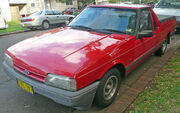
1993–1996 Ford XG Falcon GLi utility
XG[]
When the XF Falcon passenger car range was replaced by the redesigned EA series, the XF commercials (utility and panel van) continued unchanged due to there being no EA series versions. The XF commercial models continued unchanged stylistically, but over time would gain the EB series engine updates.
The XG, released in March 1993, represented the most significant update to the Falcon commercials in five years. Aside from a new name—the ute was referred to as the 'Falcon Longreach'—the XG got a new engine, an exterior facelift, and lost the 3 speed (or 3-on-the-tree) column-shift manual transmission (3 speed column-Auto remained) along with 5 speed manual. Ford Australia added the Longreach name for its tough "workhorse" image, as the birthplace of Qantas and the home of the famous Australian Stockman's Hall of Fame on the boundaries of the outback. The model was introduced to the media in Longreach.
The XG was essentially an update of the XF. It gained the EB II's 4.0L OHC inline six-cylinder engine, with either a five-speed manual or four-speed auto transmissions (floor or column shift), meaning Ford could retire the old engine and transmission options. It also gained interior updates from the EB including the instrument cluster, centre console (in two seater models), steering wheel, seats. Exterior changes were minimal, and included an EB-style grill, black window trims (as opposed to chrome on XF's) EB style door 'rubbing' strips, and indicator lights on the front quarter panels.
An XR6 model was released in October 1993. Over the standard model, it gained the ED's XR6 161 kilowatts (216 hp) engine, distinctive quad headlights, indicators in the front bumper (due to the different headlights), sportier suspension, ED XR6 seats, trim, 15 inch five-spoke alloy wheels and exterior badging. 1,050 XR6s were sold between October 1993 and March 1996.
XH[]

1996–1997 Ford XH Falcon Longreach panel van
The XH series Falcon utility and van, released in 1996,[14] were essentially XG models facelifted to resemble the contemporary Falcon EF sedans and wagons. The XH also gained an all-new front suspension and rack and pinion steering from the EA–EL series cars. This meant all that the frame & bodywork from the firewall forward was changed. The turret (roof) panel on the utility was now domed and lost its squared-off appearance, increasing interior head room. By this time, the popularity of the panel van had faded and Ford released their final Falcon panel van in 1997 as part of the revised XH II series. It was also with this model that the V8 engine was re-introduced into the Falcon utility commercial vehicle range. After 20 years, the fourth generation Falcon (XD-XE-XF-XG-XH) was discontinued in April 1999.
Fifth generation (1988–1998)[]
EA[]
- Main article: Ford EA Falcon

1988–1989 Ford EA Falcon GL sedan
As a result of an A$700 million development the Ford EA Falcon[15] introduced in 1988, bore a passing resemblance to the European Ford Scorpio.[16] However under the skin, it remained an entirely Australian design, and is credited as the first Falcon model to employ wind tunnel testing.[16] The EA was also only produced in sedan and station wagon body styles, with the previous-model (XF) utility and panel van continuing in production.[16]
Engine choices comprised three straight-six engines: the short-lived, CFI 3.2 litre, a 3.9 litre, as well as a 3.9 litre multi-point. A five-speed T50D fully synchronised manual and Borg-Warner M51 three-speed automatic transmission were offered, however the latter was replaced by a four-speed BTR 85SXLE in the Series II range then updated to the BTR 95LE in the EB update in 1991.
The EA Falcon was available in four trim levels: the base model was named GL and was equipped with the 3.2 litre straight-six, although most GLs were sold with the 3.9 CFI. The 3.9 litre CFI engine was available in the sporty Falcon S and in the luxurious Fairmont; the MPI version was standard only in the top of the range Fairmont Ghia.

1990–1991 Ford EA II Falcon GL station wagon
The EA Falcon, released under the codename EA26 (E for the large size, A for Australia, 26 for the (usually in sequence) global project number), would retain the traditional Falcon hallmarks of width and rear-wheel drive. This proved to be the correct move as sales of the Falcon began to climb after the fuel crisis aftermath, while those of the rival Commodore slipped. It became clear that Australian buying patterns had not truly changed and what the public wanted was a full-size (albeit smaller) family car.
In addition, Ford's dominance of the taxi market in Australia meant that a car that could comfortably seat three along the back seat—and even the front, with a bench seat installed—was necessary. It also ensured that Ford could retain, at least until Holden released the new Statesman/Caprice in 1990, the market for official cars for governmental use.
While initially popular, the EA's build quality was uncompetitive with uneven panel shutlines, computer problems, poor paint quality and front suspension alignment problems.[16][17]
Launched in October 1989, the Series II brought with it a four-speed automatic transmission, body-coloured B-pillars, and the 3.2 litre engine was dropped.[16] Despite the Series II models having significantly fewer problems than the Series I, Series II prices are also affected by curtailed resale values. The same problem also affects the NA Fairlane and DA series LTD,[18] and even the ute and panel van variants, which persisted with the older XF architecture.
EB[]
- Main article: Ford EB Falcon

1992–1993 Ford EB II Fairmont sedan
Visually the 1991 Ford EB Falcon remained nearly identical to its predecessor. The most noticeable change was the transfer of the Ford emblem from the tip of the bonnet to the grille. Additionally the air vents in C-pillars had been abolished, and reversing lamps were featured on either side of the rear number plate.[19] The return of the V8 engine was welcomed by the motoring press, however the 5.0 litre Windsor unit did not reappear in the utility variants until the "EF-shaped" XH series of 1997. There were also changes to the front suspension geometry, giving the EB a much better level of grip and steering feel.[19] With the new model, Ford re-introduced the sports orientated GT specification level, an exclusive 250 unit run celebrating the 25th anniversary of the first original Falcon GT.[20] The first XR6 and XR8 sports models appeared in the EB Series.[21]
The radically different Series II model, appearing in showrooms in April 1992, saw the six-cylinder engine upsized by 35 cubic centimetres (from 3949 cc to 3984 cc). This brought the nominal total swept capacity to 4.0 litres.[19] The transmission and electronics were also improved, and there were tweaks to the styling. The base model now had body-coloured bumpers, and the previously matte black plastic exterior door handles were now given a glossy finish. The update reportedly cost A$1 million.[19]
Innovation became an evident strength in the EB II: anti-lock brakes became an option, and in 1993, a lap sash centre rear seatbelt became standard.[19] The EB also introduced the "Smartlock" security locking system. South Australian Police revealed the operational success of "Smartlock", by inviting four professional car thieves to steal an EB specified with the locking system. The thieves were unsuccessful at their attempt, giving up after four days.[19] Foam-filled A-pillars also featured, which greatly increased crush protection and stiffened the frame, thus helping to reduce Noise, Vibration, and Harshness.[19]
ED[]
- Main article: Ford ED Falcon

1993–1994 Ford ED Falcon GLi station wagon
The ED Falcon came in response to Holden's new VR Commodore in 1993. The front grille was now elliptical to differentiate it from the EB,[22] and the sports genre (XR6, and XR8) gained an exclusive quad headlamp cluster.[23] Making a comeback in the ED range was the Futura. The safety orientated Futura was marketed towards private buyers, and was equipped with cruise control, anti-lock brakes, and featured body-coloured mirrors.[22] For the first time since the XF series, the luxurious Fairmont Ghia trim level was not available in station wagon form.[22] The standard 4.0Litre six cylinder produced 145 kW (197 PS/194 hp), the XR6 high performance option 164 kW (223 PS/220 hp), and the 5.0Litre SEFI V8 165 kW (224 PS/221 hp) at 4500 rpm.
EF[]
- Main article: Ford EF Falcon

1994–1995 Ford EF Falcon GLi sedan
When the facelifted EF was introduced in August 1994, it brought with it a new curvaceous body shape while sharing its doors (albeit, with a new door handle design) and most of its body structure with the earlier EA–ED series cars.[24] Unlike the sedan, the station wagon inherited the rear styling of the ED series.[24] With the new model, came a thoroughly redesigned interior. Cup holders were now prominent features in all models, and Ford paid particular attention to safety.[24] A driver's airbag was made standard on all variants, a first for an Australian car,[24] even though the Holden VR Commodore was the first to feature it as an option.[25] From the outside, the reinforced body gave added rollover strength and front collision protection. An original innovation introduced in the EF range was the "Smart Bar". A bullbar developed to work seamlessly with the vehicle's airbag system.[24]
The 4.0 litre inline six-cylinder engine was upgraded to aid refinement and increase power to 157 kilowatts (211 hp) this included the removal of the distributor as it was replaced with a coil-pack ignition system which was a first for the Falcon. Also the intake manifold was changed to include a dual length system which involved intake runners of two different lengths and a valve to switch between the two.[24] Changes were also made to the suspension with the aim of providing a more supple ride, but drew criticism for producing nervous handling and an unsettling feeling of roll oversteer (a problem not corrected until the EL facelift).[24][26]
A passenger airbag was offered as an option in the Series II facelift of October 1995. The unique design allowed it to protect the not only the front passenger, but the centre passenger as well (only the entry-level GLi was offered with the optional bench seat).[24] The Fairmont Ghia was the only trim level to receive dual airbags as standard, which also benefited from the XR6 engine, leather upholstery, extensive use of chrome and lowered suspension.[24] With the use of neoprene rubber insulation, road and wind noise was cut off from within the cabin, contributing to vehicle refinement. Ford also dropped the XR6 station wagon from the lineup in the Series II.[24]
The EF Series also saw the first use of polycarbonate headlight lenses instead of glass, saving weight and gaining shatter resistance.
EL[]
- Main article: Ford EL Falcon

1997 Ford EL Falcon GLi sedan
The final E-series model, the EL Falcon, was merely a facelift of the EF intended to keep sales strong until the sixth generation AU falcon was launched.[26] The most obvious change visually, was the return of the grille on the GLi and Futura spec levels. The new oval grille tied in with Ford's global lineup of the time. Cosmetic updates extended further with the bonnet, front bumper and headlamps also receiving a revised design.[26] New grilles were now prominent on the luxury variants (Fairmont and Fairmont Ghia), and the quad-headlamps of the XR sport models gained minor changes. New wheel trims were featured on all trim levels, and station wagon variants gained white tinted indicator lenses, replacing the amber tint which had been common since the introduction of the EA.[26]
With the EL there was a revision again with the engine this time the distributor was refitted and the coil-pack ignition removed, though power remained the same 157 kilowatts (211 hp) at 4900 rpm / 357 newton metres (263 lb·ft) at 3000 rpm.
To address handling concerns with the EF, improvements were made to the rear suspension and steering which would largely be attributed to Ford Australia's association with Tickford. Speed-sensitive power steering on the Fairmont Ghia made parking more straightforward, without compromising high speed steering.[26] With the exception of the GLi, the entire range was fitted with standard Bosch 5.3 ABS brakes, and an advanced window film known as "Smart Tint" gave equivalent protection levels of SPF15 sunscreen.[26]
Interior upgrades ranged from reshaped seats and headrests, to new colour schemes, and switches. Station wagons could now be ordered with third-row accommodation and an electric network for mobile phone usage.[26]
Sixth generation (1998–2008)[]
AU[]
- Main article: Ford AU Falcon

2002 Ford AU III Falcon SR sedan
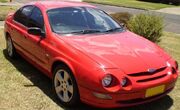
1999 Ford AU series I XR6 sedan
The new generation AU Falcon was released in 1998. Initially, the company looked at various other Ford products such as the Ford Taurus, Mazda 929, and the European Scorpio as replacements for the Falcon. After serious evaluation, Ford Australia decided to continue with the Falcon, partly because of the investment required and the effect on local employment. Developed under the code name "EA169", AU adopted Ford's New Edge styling, which was meant to differentiate it from the "conformist" styling prevalent in the 1990s.[27] The gamble, which had worked with the Ford Focus, did not particularly endear the AU Falcon to its buyers. Ford attempted to address the AUs issues in its Series II (April 2000) and Series III (November 2001) updates, which brought minor styling changes such as a raised bonnet across the range (excluding XR6 and XR8 models), and the scrapping of the unpopular "waterfall" grill on the base model Forte. The series 2 and 3 also received larger brakes on the front with 278mm rotors and twin piston calipers. the new brakes required 16 inch rims to be fitted. from series 2 the smartlock system was replaced with a more secure smartshield system with a transponder located in the key preventing someone from copying your key and stealing your car. the new key can only be programed in if you have 2 pre programed keys or with a ford computer.[27] A laminated firewall was implemented to reduce NVH, and the V8 received incremental power upgrades among other things. Due to the AU's controversial styling, sales did not meet expectations, being outsold by its chief rival, the Holden VT, and VX Commodores.[28]
BA[]
- Main article: Ford BA Falcon

2002–2004 Ford BA Falcon XR6 sedan

2004–2005 Ford BA II Falcon XT sedan
Officially debuting in September 2002, the Ford BA Falcon was a major update of the AU, with Ford designers and engineers almost wiping the board clean, and in the process spending just over $500 million, a figure much larger than previously anticipated. The BA Falcon won the prestigious Wheels Car of the Year Award (COTY) in 2002. Major elements of the overhaul included the development of a more effective Control-Blade independent rear suspension, a significant revamp of the car's inline 6-cylinder engine as well as two new V8 engines and, to top it all off, new transmissions. Design wise, the BA received a completely new look, with designers giving both the front and rear quarters of the car substantial work, resulting in much more contemporary , European-style design. The BA also introduced a thoroughly remodelled interior, whereby the 'oval shaped' instrument cluster was replaced with a more conservatively styled cluster. It featured a large LCD screen, situated in a "satin finished" centre console (Called the "Interior Command Centre" or ICC in short).[29] Within a year of its release, Falcon sales had increased substantially and, for a time, eclipsed Holden Commodore sales.[30]
Ford introduced their new Barra straight-six 4.0 litre DOHC VCT engines into the lineup, which included a turbocharged (240 kilowatts (320 hp)/450 newton metres (330 lb·ft)) version and base line (182 kilowatts (244 hp)/380 newton metres (280 lb·ft)) naturally aspirated version. The BA also featured a new North American designed 5.4 litre 4V Boss and Barra 3V V8 engines. The Barra 220 (220 kilowatts (300 hp)/472 newton metres (348 lb·ft)) Boss 260 (260 kilowatts (350 hp)/500 newton metres (370 lb·ft)) and Boss 290 (290 kilowatts (390 hp)/520 newton metres (380 lb·ft)) engines were smoother, quieter and more fuel efficient than the Ford Windsor engine used in the AU.[31] In October 2004, Ford released the Mark II update of the BA. Amongst the changes was a six-speed manual transmission, four new exterior colours, and revised wheels trims.[32]
In 2004 Ford introduced the Territory SUV which was based upon the BA's engine, floorpan and IRS. This was introduced in response to the long term decline in large sedan sales in Australia, since this sector's share of the total market has been steadily shrinking for a decade.
BF[]
- Main article: Ford BF Falcon
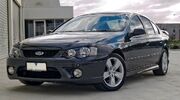
2005–2007 Ford BF Falcon XR6 sedan

The Mark II update of the BF range featured a modified front-end, which improved fuel efficiency
Visually similar to its forerunner, the BF update from October 2005 was developed with an emphasis geared more towards powertrain enhancements, rather than design. The BF Falcon received various mechanical upgrades, including engine modifications and improvements towards noise, vibration, and harshness. The naturally aspirated six-cylinder engine gained an increase in power to (190 kilowatts (250 hp), while also bringing improvements in fuel economy and compliance with Euro III emission standards.[33] The turbocharged version of same engine also received further gains in output, with peak power rising to 245 kilowatts (329 hp) and 480 N·m (350 lb·ft) of torque. Ford, with the BF, also introduced the six-speed ZF 6HP26 automatic transmission and electronic stability control, both of which were made available on selected trim levels.[33]
Ford updated its Falcon lineup with the Mark II update in October 2006. Select trim levels in the BF II range (XT, Futura and Fairmont) saw a modified front-end, which featured more of a sporting image and was more aerodynamic. The entry-level XT could now be specified with the six-speed automatic, with four-speed-automatic continued as the standard transmission. Fuel efficiency figures also improved, with figures of 10.7 L/100 km (22 mpg-US/26 mpg-imp) for the base XT and 10.2 L/100 km (23 mpg-US/28 mpg-imp) for variants fitted with the ZF six-speed automatic.[34]
Following the release of the FG Falcon model in 2008, the BF wagon was revised and re-released in Mark III guise. Production continues as of December 2009.
At the end of 2010 the Falcon wagon was discontinued. Instead, Ford pitched the smaller Ford Mondeo wagon as an alternative for buyers wanting the flexibility of a wagon.[35] The last petrol-engined BF was built on 30 June, while LPG E-Gas models continued until September 2010.[36]
Seventh generation (2008–)[]

Ford FG Falcon XT

Ford FG Falcon XR6 Turbo
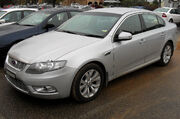
Ford FG G6E

FPV FG GT Boss 315
FG[]
- Main article: Ford FG Falcon
The seventh generation Falcon, known as the FG, was announced at a press event on 17 February 2008. The FG moniker references the now discontinued Fairmont Ghia. The longstanding Futura and Fairmont models have been discontinued, having been replaced by the G6 and G6E models respectively. The Fairmont V8 has been replaced by the G6E Turbo.
The inline six-cylinder engine received a power upgrade of 5 kilowatts (6.7 hp) and 8 newton metres (5.9 lb·ft) to 195 kilowatts (261 hp) at 6000 rpm/391 newton metres (288 lb·ft) at 3250 rpm. The engine can also use 95 RON fuel, adding 3 kilowatts (4.0 hp) and 18 newton metres (13 lb·ft), a figure higher again on 98 RON fuel where certain sources would claim 420Nm of torque and 208 kW on RON98 petrol. The turbocharged engine used in the XR6 Turbo and G6E Turbo models produces (270 kilowatts (360 hp) and 533 newton metres (393 lb·ft)). The power output of is similar to previous FPV turbos, but it is a substantially modified design: the new induction system which includes a bigger and more efficient intercooler, higher compression ratio, extra boost and strengthened internals are the key changes. The XT, G6 and G6E also have an E-Gas (LPG) option. The engine continues to use a similar VCT system as its BA/BF predecessors. Fuel consumption has been improved over the outgoing model.[37] The XR6 Turbo received MOTOR magazine's Bang for your Buck 2008 award.
The FG adds a "Virtual-Pivot" system to the front suspension designed to improve levels of steering, handling and turn-in; and complements Ford's Control-Blade IRS system first introduced on the BA Falcon in 2002.
The XR8 is the only V8 model in Ford's FG Falcon lineup (although Ford Australia's performance arm, FPV, produces a number of V8 powered models). Higher-end models also feature the wireless Bluetooth integration for mobiles and full iPod integration. The Falcon XR8's 5.4-litre V8 produces 290 kilowatts (390 hp)/520 newton metres (380 lb·ft).
The new FPV engines are more powerful than ever, and also more fuel efficient. The F6's 4.0 litre inline-six cylinder turbo engine now produces 310 kilowatts (420 hp) of power and 565 newton metres (417 lb·ft) of torque. The GT's 5.4 litre V8 now has 315 kilowatts (422 hp) of power, hence its name Boss 315. The GT's torque figure is rated at 551 newton metres (406 lb·ft).
In 2010, FPV replaced the 5.4-litre with a locally developed, supercharged version of Ford's 5.0-litre 'modular V8' engine code-named Miami. Initially two versions were released, one rated at 315 kilowatts (422 hp) and 545 newton metres (402 lb·ft) of torque and the other at 335 kilowatts (449 hp) and 570 newton metres (420 lb·ft) of torque. Both engines carry the 'Boss' moniker, with the 315kW version dubbed the "Boss 315", and the more powerful version dubbed the "Boss 335".
The FG Falcon was the first Australian manufactured car to achieve five stars in the independent Australasian New Car Assessment Program (ANCAP) crash safety testing.[38] It achieved a score of 34.6 out of 37.
Future changes[]
In 2010 Ford Australia celebrated 50 years of continuous Falcon production, from 1960 to date.
The first update to the FG model was released in the second-half of 2010. Unlike in pevious generations such as the BA and BF where a minor model update was referred to as "Mk II", Ford have instead labelled all cars made after October 2010 with the "FG Update" label. The update adds several small interior elements as standard to all vehicles. iPod Integration and Bluetooth are now standard across the range and the popular ZF 6-speed Gearbox has also been made standard across the range, spelling the end of the 4 and 5 speed variants. Other changes included an alternative wheel rim design and new floor mat and side step designs. Curtain Airbags have remained as a $300 optional extra.
A new liquid-injection E-Gas engine is to be introduced in second-half 2011. It is expected to provide superior performance and fuel usage compared to the current E-gas models through its use of liquid injection.
It was announced in mid-2009 that Ford would begin production of a direct-injection, turbocharged four-cylinder "Ecoboost" version of the Falcon; it will be the first rear wheel drive application of Ford's new EcoBoost engine, and will begin production in 2011.[39] The new EcoBoost engine debuted in February 2011 in the Volvo XC60 and S60 [40]. It is expected that the same engine will be used in the EcoBoost Falcon, but possibly with better power figures to entice fleet buyers who are wary of the performance hit the 4 cylinder engine may have on the large car.
Based on Ford's upgrade history with its sixth generation models, it is likely that a successor to the FG (a BA to BF step up) will be released in late 2011 or early 2012. It is possible that the release of the new model may coincide with the release of the 4 cylinder EcoBoost Falcon and the return of the XR8 with the 5.0L Coyote engine, both of which are expected to occur in the second-half of 2011.
In 2016 the Falcon may be replaced by a large car platform that is to be built for all world markets, which could be either a global rear wheel drive platform or the transverse front/all-wheel drive Taurus platform, or possibly some other approach, a decision on that will be made in 2012.[41] Ford's European design head Martin Smith has pointed out the Taurus platform could not be a true replacement for the rear drive Falcon,[42] and Ford Australia chief Marin Burela has stated that no decision has been made on Falcon, and its future for now is safe, and the Falcon could share its platform with other rear wheel drive Fords, like Mustang.[43] This was confirmed by Ford CEO Alan Mulally[44]
Falcon utility[]

2005–2006 Ford BF Falcon XR6 Turbo utility
The Australian affection for the ute (short for "utility") allowed the Falcon to serve as the base model for their line of utes and panel vans, starting in 1961 and gaining rapid recognition by (usually younger) enthusiasts by the mid-1960s. As the base sedan and station wagon models of the Falcon further evolved, so too did the ute and panel van models, although usually up to a year or so after initial release into the market. The only exception was the XF series, which lasted through the initial EA26 era. While EA26 ute prototypes were actually built, the XF shell continued through to the 1998 release of the AU model, in 1996 gaining the nose treatment of the then current EF series Falcon, with a combination of XF and E-Series Interiors. Low Series XH utes did not have airbags, for example.
Exports[]
Australian Falcon exports have traditionally been confined to right-hand-drive countries in the Asia-Pacific region, such as New Zealand (where Ford New Zealand sometimes devised local trim models, such as the Falcon 600), and Pacific Island nations like Papua New Guinea and Fiji. New Zealand assembly of the Falcon in Wiri ceased in the early 1990s, after which, all Falcons sold in New Zealand have been fully imported from Australia.
The only significant export market for the Falcon outside of Oceania has been South Africa, where it was released in 1996 after an absence of over 20 years, but was dropped in 2003. Some limousines and hearses (inc. LPG-only powered Utes) are exported to the UK by Coleman Milne, who used to convert European-made Granadas and Scorpios for the same purposes.
Hong Kong also imported a small batch of LPG-powered AU Falcon station wagons for trial as taxis, and although it initially found favour in luggage capacity with operators when compared to mainstream taxis like the Toyota Comfort, it has not seen success there, citing higher operating costs.
Ford had intended developing the car with left hand drive export potential, and received federal and state government grants to assist, but in October 2007 it was announced by Ford Australia president Tom Gorman that the left-hand-drive Falcon project was to be abandoned and the export incentive grant money would be directed to construction of the Ford Focus small-car in Australia. As the FG Falcon utilizes much of the previous model's architecture, converting it to left hand drive would have been a costly and time consuming process.[45]
Ford Australia has stated that they have considered exporting the FG Falcon to China and the Middle East.[46]
References[]
| This page uses some content from Wikipedia. The original article was at Ford Falcon (Australia). The list of authors can be seen in the page history. As with Tractor & Construction Plant Wiki, the text of Wikipedia is available under the Creative Commons by Attribution License and/or GNU Free Documentation License. Please check page history for when the original article was copied to Wikia |
- ↑ "Ford Heritage". Ford Motor Company of Australia. Archived from the original on 2005-12-23.
- ↑ "Market place", Wheels magazine (Australian Consolidated Press): 134. September 2007.
- ↑ "Ford Falcon Celebrates 45th Birthday". Motoring Channel Staff (2005-06-28). Retrieved on 2007-06-29.
- ↑ "Ford Falcon XK". Unique Cars and Parts. Retrieved on 2007-06-15.
- ↑ 5.0 5.1 5.2 5.3 5.4 5.5 5.6 Bushby, A. C. (1989). The Australian Ford Falcon. A.C. Bushby. ISBN 073163621X.
- ↑ "Ford Falcon XL". Unique Cars and Parts. Retrieved on 2007-06-29.
- ↑ "Ford Falcon XP". Unique Cars and Parts. Retrieved on 2007-06-29.
- ↑ Local Falcon gets V8!, Wheels magazine. January 1965, http://www.stormloader.com/falconccwa/temphint.htm. Retrieved on .
- ↑ 9.0 9.1 9.2 Falcon XR technical_specifications Retrieved from www.uniquecarsandparts.com.au on 5 January 2009
- ↑ 10.0 10.1 Norm Darwin, The History of Ford in Australia, 1986, page 160
- ↑ Wheels magazine (Australian Consolidated Press). October 1971.
- ↑ Tony Davis, Aussie Cars, 1987, page 135
- ↑ Jennings, Bob (2000-04-17). "The Falcon that never was". Drive. Fairfax Digital. Retrieved on 2007-11-05.
- ↑ XH Falcon Retrieved from Falcon Facts on 3 February 2009
- ↑ "Ford Falcon EA". Unique Cars and Parts. Retrieved on 2007-06-06.
- ↑ 16.0 16.1 16.2 16.3 16.4 "EA Falcon (1988 - 1991)". Falcon Facts. Retrieved on 2007-06-06.
- ↑ Morley, David (2004-06-08). "Ford Falcon EA". Drive. Fairfax Digital. Retrieved on 2007-06-06.
- ↑ "Used car test - Ford Fairlane". Drive publisher = Fairfax Media (1999-02-26). Retrieved on 2007-05-14.
- ↑ 19.0 19.1 19.2 19.3 19.4 19.5 19.6 "EB Falcon (1991 - 1993)". Falcon Facts. Retrieved on 2007-06-06.
- ↑ Warner, Gary. "Falcon GT - style and substance (if you can find one)". FastLane. Retrieved on 2007-09-18.
- ↑ "Ford Falcon EB". Unique Cars and Parts. Retrieved on 2008-02-15.
- ↑ 22.0 22.1 22.2 "ED Falcon (1993 - 1994)". Falcon Facts. Retrieved on 2007-06-08.
- ↑ "Ford Falcon ED". Unique Cars and Parts. Retrieved on 2007-06-08.
- ↑ 24.0 24.1 24.2 24.3 24.4 24.5 24.6 24.7 24.8 24.9 "EF Falcon (1994 - 1996)". Falcon Facts. Retrieved on 2007-06-09.
- ↑ Smith, Graham (2002-09-06). "1993 Holden VR Commodore". Herald Sun. Retrieved on 2008-02-21.
- ↑ 26.0 26.1 26.2 26.3 26.4 26.5 26.6 "EL Falcon (1996 - 1998)". Falcon Facts. Retrieved on 2007-06-08.
- ↑ 27.0 27.1 "The good, the bad, the Falcon". Drive. Fairfax Media. Retrieved on 2007-06-04.
- ↑ "Falcon Raises the Bar". Web Publications (2000-04-05). Retrieved on 2007-06-05.
- ↑ "BA Falcon Interior Reveal". Web Publications (2002-09-05). Retrieved on 2007-06-02.
- ↑ "Number Crunching" (November 2003), p. 155.
- ↑ "BA Falcon Engine Reveal". Web Publications (2002-09-05). Retrieved on 2007-06-02.
- ↑ Torr, Feann. "BA Ford Falcon MkII: First Look". WebWombat. Retrieved on 2007-06-02.
- ↑ 33.0 33.1 Torr, Feann (2005-10-20). "Road Test: BF Ford Falcon". WebWombat. Retrieved on 2007-06-03.
- ↑ Hepworth, Kevin (2006-10-04). "Ford Falcon BF II: pricing, testdrive". News.com.au. Retrieved on 2007-06-03.
- ↑ Hagon, Toby (2010-03-25). "Brakes put on Falcon wagon". The Age. Retrieved on 2010-03-30.
- ↑ Brogan, Matt (2010-03-25). "Ford Falcon wagon to be retired by June". Australian Car Advice. Retrieved on 2010-04-08.
- ↑ "Wheels - Wheels Magazine - Car Reviews - Road Tests - Wheelsmag".
- ↑ Weekend Australian 9–10 August 2008
- ↑ Pettendy, Marton (2009-07-27). "Ford Falcon EcoBoosted". GoAuto. John Mellor. Retrieved on 2009-12-06.
- ↑ Harris, Chris (24 February 2011). "Falcon's new turbo debuts in Volvos". Retrieved on 1 March 2011.
- ↑ June 30, 2010 edition (#538) of GoAutoNews
- ↑ GoAutoMedia (2009-04-27). "Ford 2010 Taurus - Taurus can’t replace Falcon: designer". GoAuto. Retrieved on 2010-04-04.
- ↑ "Falcon confirmed to continue | Review". carsguide.com.au. Retrieved on 2010-04-04.
- ↑ "Falcon to fly on Mustang platform | Review". carsguide.com.au. Retrieved on 2010-04-04.
- ↑ Newton, Bruce (2007-10-22). "Ford abandons export plans for new Falcon". Drive. Fairfax Media. Retrieved on 2007-11-05.
- ↑ Ford hopes to export FG Falcon The Press 28 April 2008
| ||||||||||||||
| Ford Motor Company of Australia, automobile timeline, 1980s–present | ||||||||||||||||||||||||||||||
|---|---|---|---|---|---|---|---|---|---|---|---|---|---|---|---|---|---|---|---|---|---|---|---|---|---|---|---|---|---|---|
| Type | 1980s | 1990s | 2000s | |||||||||||||||||||||||||||
| 0 | 1 | 2 | 3 | 4 | 5 | 6 | 7 | 8 | 9 | 0 | 1 | 2 | 3 | 4 | 5 | 6 | 7 | 8 | 9 | 0 | 1 | 2 | 3 | 4 | 5 | 6 | 7 | 8 | 9 | |
| City | Ka | |||||||||||||||||||||||||||||
| Subcompact | Festiva | Festiva | Fiesta | Fiesta | ||||||||||||||||||||||||||
| Compact | Escort | Laser | Laser | Laser | Laser | Laser | Focus | Focus | ||||||||||||||||||||||
| Meteor | ||||||||||||||||||||||||||||||
| Mid-size | Cortina | Telstar | Telstar | Taurus | ||||||||||||||||||||||||||
| Corsair | Mondeo | Mondeo | ||||||||||||||||||||||||||||
| Full-size | Falcon / Fairmont | Falcon / Fairmont | Falcon / Fairmont | Falcon / G Series | ||||||||||||||||||||||||||
| Fairlane / LTD | Fairlane / LTD | Fairlane / LTD | ||||||||||||||||||||||||||||
| Sports | Capri | Probe | Cougar | |||||||||||||||||||||||||||
| Mustang | ||||||||||||||||||||||||||||||
| Utility | Courier | Courier | Ranger | |||||||||||||||||||||||||||
| Falcon Ute | Falcon Ute | Falcon Ute | ||||||||||||||||||||||||||||
| Van | Falcon Van | |||||||||||||||||||||||||||||
| Spectron | ||||||||||||||||||||||||||||||
| Econovan | Econovan | Econovan | ||||||||||||||||||||||||||||
| Transit | Transit | Transit | ||||||||||||||||||||||||||||
| Compact SUV | Escape | |||||||||||||||||||||||||||||
| Mid-size SUV | Raider | Territory | ||||||||||||||||||||||||||||
| Bronco | Maverick | Explorer | Explorer | |||||||||||||||||||||||||||
| |||||||||||||||||||||||||||||||||||||||||||||||